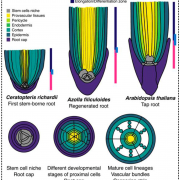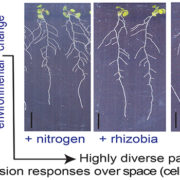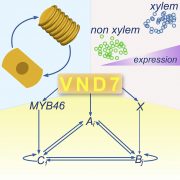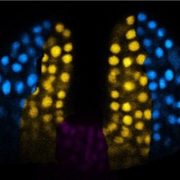Brassinosteroids modulate meristem fate and differentiation of unique inflorescence morphology in Setaria viridis
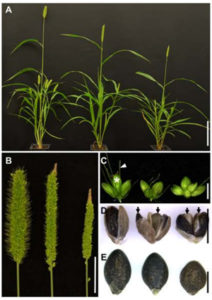 Plant Cell. The yield potential of crops is strongly influenced by floral architecture, a trait determined by the fate of stem cells in meristematic tissue. Meristems themselves are influenced by several factors, including phytohormones such as brassinosteroids (BRs) and gibberellic acid (GA). BRs act locally to promote growth, but can also affect the accumulation of GA to indirectly influence elongation of cells. Yang et al. used a BR deficient mutant of the grass Setaria viridis (bristleless 1, bsl1) to demonstrate that manipulation of BR synthesis can influence floral architecture. The bsl1 mutants had smaller seeds, and were semi-dwarf with an increased number of tillers. Panicles in bsl1 mutants were shorter and thinner than wild-type, lacked bristles, and contained some spikelets with two seeds (wild-type spikelets all produced one seed). Electron microscopy revealed that branch meristems that would normally form bristles instead formed spikelet meristems in bsl1. The phenotypes seen in bsl1 were confirmed by application of propiconazole, a BR synthesis inhibitor. Increasing seed number provides great potential for boosting yield, and this work is readily translatable to the world’s major crops (rice, wheat, maize), as-well-as locally-important subsistence crops. (Summary by Mike Page) Plant Cell 10.1105/tpc.17.00816
Plant Cell. The yield potential of crops is strongly influenced by floral architecture, a trait determined by the fate of stem cells in meristematic tissue. Meristems themselves are influenced by several factors, including phytohormones such as brassinosteroids (BRs) and gibberellic acid (GA). BRs act locally to promote growth, but can also affect the accumulation of GA to indirectly influence elongation of cells. Yang et al. used a BR deficient mutant of the grass Setaria viridis (bristleless 1, bsl1) to demonstrate that manipulation of BR synthesis can influence floral architecture. The bsl1 mutants had smaller seeds, and were semi-dwarf with an increased number of tillers. Panicles in bsl1 mutants were shorter and thinner than wild-type, lacked bristles, and contained some spikelets with two seeds (wild-type spikelets all produced one seed). Electron microscopy revealed that branch meristems that would normally form bristles instead formed spikelet meristems in bsl1. The phenotypes seen in bsl1 were confirmed by application of propiconazole, a BR synthesis inhibitor. Increasing seed number provides great potential for boosting yield, and this work is readily translatable to the world’s major crops (rice, wheat, maize), as-well-as locally-important subsistence crops. (Summary by Mike Page) Plant Cell 10.1105/tpc.17.00816


